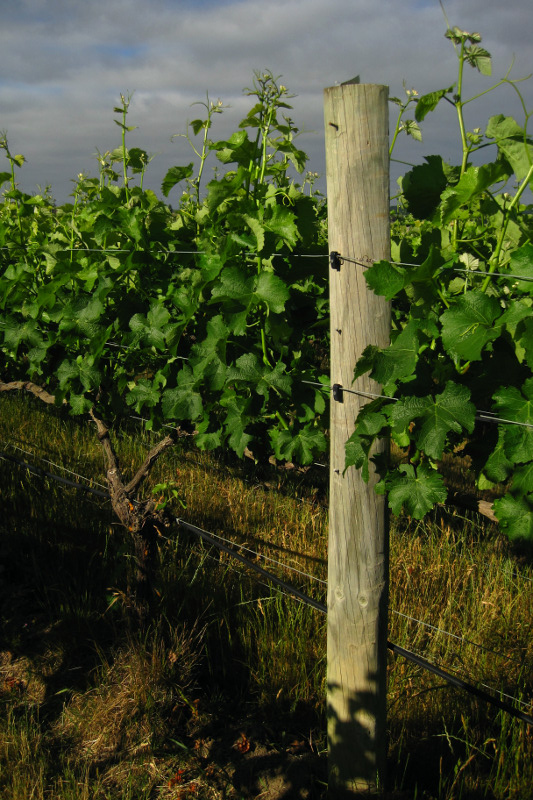Shoot thinning and wire lifting
After a short break in Nelson and later Blenheim, we found ourselves another wwoofing gig (previously we spent a week milking goats) at an estate vineyard and winery in the Marlborough region, well-known for its Sauvignon Blanc. The vineyard is composed of 3 separate tracts of land, totaling 163 hectares, producing around 25-30 thousand cases of wine a year (a case is twelve 750ml bottles). They also have olive trees on the estate for olive oil (did you know the oil comes from the pit and not the flesh? me neither…), some livestock (3 cows, 2 horses, sheep, and a dozen chickens), and vegetable gardens.
A week ago Friday (Nov 26) the estate manager picked us up at our backpacker in Blenheim and brought us to the house on one of their properties where we’d be staying. One of the full time employees lives there and looks after the wwoofers, which included one other person during our first week, an 18 year old from Canada. Afterwards he took us on a tour of the vineyard where we’d be working.
What are our days like? Every morning we set the alarm for 6:15 in order to have time to make breakfast and tea and get lunch together for the day. We leave the house around 7:10 on bikes they’ve provided, cycling 5km up the road to the main vineyard property. We find out what we’re going to be doing and usually start around 7:30. Most activities are done in groups, so we’re rarely alone—usually chatting with the people who work there full time. At 10:00 we break for morning tea—which amounts to a “second breakfast” given the substantial amount of food consumed for the day ahead. We resume working until 1:00 when everyone breaks for lunch—usually leftovers supplemented by eggs and olive oil from the vineyard. Then we take off after lunch and ride the bikes back to the house, to shower, relax, and eventually prepare for dinner, which we cook ourselves with food supplied by the hosts.
The primary vineyard activity we’ve been involved in is “shoot thinning”. Essentially we’re pruning the just-beginning-to-flower vines to concentrate the flavors and sugars in fewer bunches of future grapes. The more you thin, the better the grapes, the more expensive the wine. Of course very few people buy expensive wine, and cheaper bottles of wine sell in greater volumes with higher margins, so there’s a balancing act when pruning between maximizing quality and maximizing revenue. At least that was my understanding as we were taught to thin each bay (the area in a row of vines between two wood posts, about 7-8 meters apart, containing 3-4 vines) from 200 shoots to 100. Based on how much a bay had been thinned, and the variety of the grape, they could tell you how much a bottle of wine would be priced. In fact they’d often refer to certain rows as $25 Sauvignon Blanc or $45 Pinot Noir.
The other vineyard activity we’ve been involved in is “wire lifting”. The grape vines are grown on a trellise system known as “vertical shoot positioning” or VSP in which the vine grows vertically (like a tree) about 80cm off the ground, and then splits in two, running along a wire fixed to the posts about 80cm in each direction. Up from these horizontal “branches” (called cordons in French) the fruiting canes (or “spurs”) are spaced out every 20cm or so, and each branches out into six or more vertical shoots. Without any assistance, the shoots would grow in every direction and eventually be weighed down by the fruit. So once the shoots have been thinned, we walk along the entire length of each row (200-300 meters) and lift two sets of movable wires up to variously spaced clips on both sides of each post, in effect sandwiching the vines vertically.







Boy that sounds like hard work! But also amazing. Loving the stories and photos.
I’m loving reading about all this, particularly since I drink a lot of Marlborough Sauvignon Blanc, so do direct me to the producer whose crops you tended!
Particularly empathise with the tissues problem – Neil is the same as Stephanie it seems. I’m about to embark on my own adventure of sorts – starting a new, international job in the corporate world in the new year. Looking forward to being a bit more cash rich, but not particularly being more time poor… Still, when the holidays finally come I can afford to go a bit further afield. I shall keep an eye on where you are next summer…
Justin I’ll never thank you enough for all your writing !!!!! Thank you !!!!! Through your stories and photos I travel and as usual you fascinate me by your adventure life and your beautiful personality. Many kisses to you and stéphanie
By the way I want to tell you I know very well what you’re doing because I’ve done it when I was young. A long time ago…… ! Good memories !!!!!!!! Love
wouldn’t it be cool if you ended up in the winemaking business? let me know if you need a cellar rat in your growing empire!
Yeah, but you should have seen this awesome thing that happened in my cube the other day….
Nelson, the hardest part is “wire dropping”—walking down the entire row dropping the wires that have been clipped at the very top of the posts before we can lift the wires and sandwich the vines upright.
Patrick, ha! It’s not all roses. Definitely gaining an appreciation for physical labor. Luckily our “wwoofer days” end after lunch.